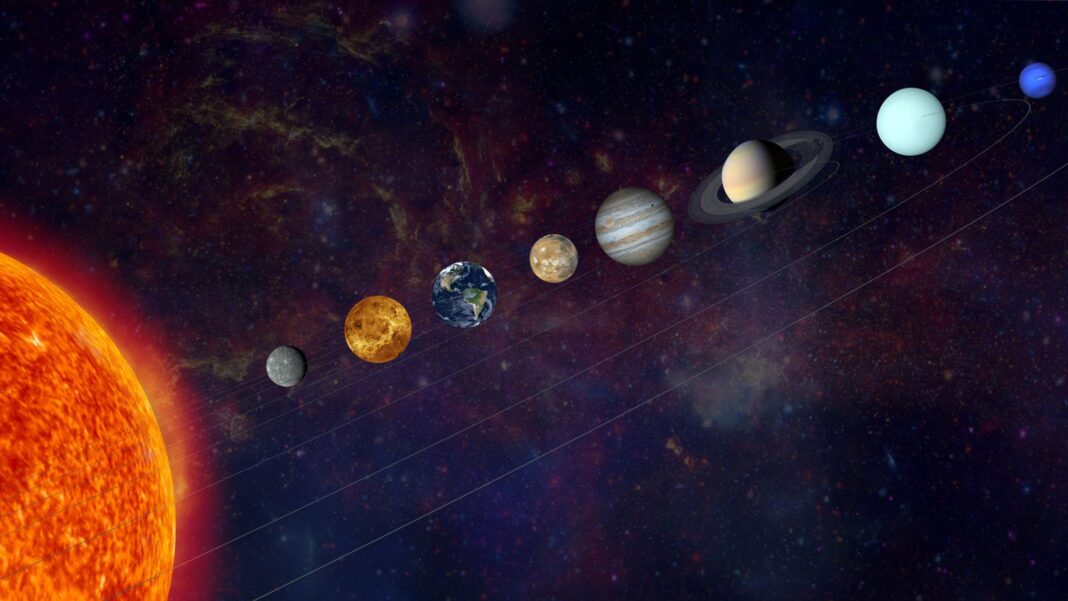Not one, not two, but seven planets are due to line up in the night skies later this week in a relatively rare planetary parade.
The phenomenon will see Mars, Jupiter, Mercury, Venus, Saturn, Uranus, Neptune and Mercury align, with some of the planets visible to the naked eye.
Keen astronomers may have already spotted six of the planets in late January or the sky earlier this month, but on 28 February, Mercury will also join the parade.
This will mean a potential of seven planets on display at once, the Greenwich Royal Observatory says.
Here is everything you need to know ahead of the phenomenon and how to maximise your chances of spotting all seven planets.
Why do the planets align?
In simple terms, as the planets in our Solar System orbit the sun, they occasionally line up in space, according to NASA.
The term planetary alignment can refer to apparent line-ups with other planets, the moon, or bright stars.
When this happens, the planets always appear along a line or an arc, NASA adds, due to the way they are viewed from Earth.
This content is provided by X, which may be using cookies and other technologies.
To show you this content, we need your permission to use cookies.
You can use the buttons below to amend your preferences to enable X cookies or to allow those cookies just once.
You can change your settings at any time via the Privacy Options.
Unfortunately we have been unable to verify if you have consented to X cookies.
To view this content you can use the button below to allow X cookies for this session only.
How rare is it?
“Planetary alignments, where multiple planets appear close together in the sky, occur periodically but are relatively rare,” Dr Shyam Balaji, researcher in astroparticle physics and cosmology at King’s College London, said last month.
He added alignments of six or more planets happen approximately every few decades, making Friday’s potential line-up even rarer.
NASA adds Mars, Jupiter, and Saturn are frequently seen in the night sky, but the addition of Venus and Mercury are particularly noteworthy.
Will UK skies be clear enough to see the planets?
There’s good news, and somewhat bad news – depending on where you are in the UK.
Sky News meteorologist Jo Robinson says there’s high pressure over the UK on Friday, meaning the weather looks good for people getting ready to watch the night skies.
Most places will also be dry with clear spells, although Robinson warns temperatures will be chilly, with the Met Office predicting “widespread” frost on Friday morning.

The moon and Jupiter high over Bamburgh Castle in Northumberland. File pic: iStock
Unfortunately, Ireland, Northern Ireland and northwest Scotland may be quite cloudy ahead of rain moving in on Friday night, Robinson says.
But, she adds, the forecast is still “several days away, so timings may change”. Any delay in the rain moving in will allow for clearer skies.
An added bonus to the upcoming planetary alignment is there will also be a new moon on 28 February. This occurs when the moon is directly between the sun and the Earth, with its shadowed side pointing towards Earth.
It means that those looking into the skies on Friday will be less affected by light pollution from the moon, and may even be able to get a good look at some galaxies, the Greenwich Royal Observatory says.
Read more from Sky News:
Mars could have had beaches and an ocean
What could happen if the 2024 YR4 asteroid hits earth?
Will you need a telescope?
Five planets: Mercury, Venus, Mars, Jupiter, and Saturn, are typically visible to the naked eye.
However, this does not guarantee they will be visible this Friday.
The Greenwich Royal Observatory says in late February it becomes much more difficult to see Saturn as it will be very low on the southwestern horizon after sunset.
NASA adds Mercury could also be difficult for observers to see without the aid of a telescope, as it may be too faint and too low.
It says to see Neptune a telescope is absolutely necessary, while Uranus, although technically bright enough to detect with good eyesight, is “quite faint and requires dark skies and precise knowledge of its location among similarly faint stars”, so a telescope is recommended.
Other top tips for planet-spotters
To help keen observers maximise their chances of seeing as many planets as possible, Dr Balaji, from King’s College London recommends the following tips:
• Find a location away from city lights
• Use current astronomical software or websites to find a planet’s latest position
• Exercise caution when observing near sunrise or sunset
• Check reliable astronomy websites for updated viewing information as the date approaches.







